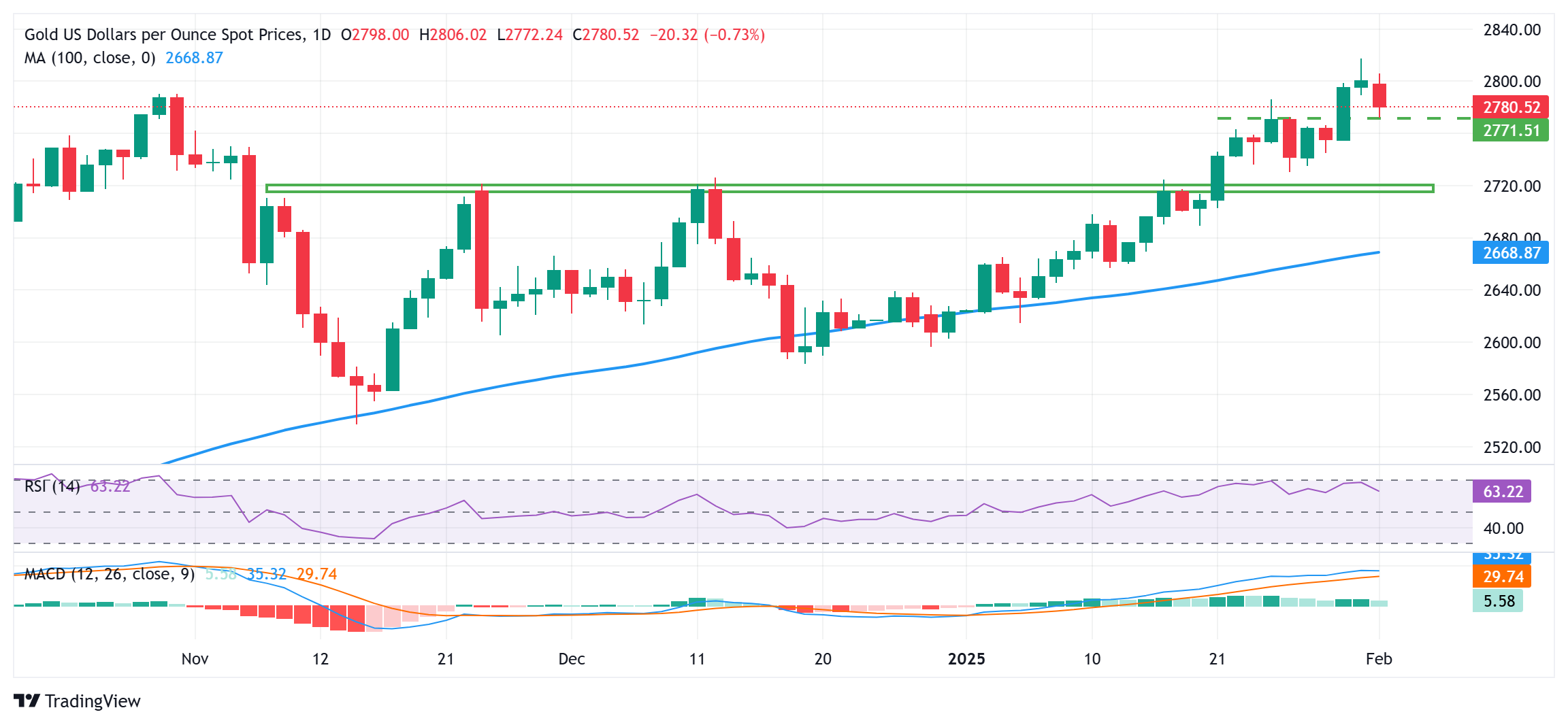Gold price drifts lower as USD jumps closer to two-year top after Trump’s new tariffs

Gold price retreats further from the record high amid a broad-based USD rally.
Concerns over Trump’s new trade tariffs offer support to the XAU/USD pair.
Bets for further policy easing by the Fed help limit losses for the commodity.
Gold price (XAU/USD) attracts heavy selling at the start of a new week and moves away from a fresh all-time peak, around the $2,717 region touched on Friday. US President Donald Trump's decision to impose tariffs on Canada, Mexico, and China lifts the US Dollar (USD) back closer to over a two-year high, which, in turn, is seen as a key factor weighing on the commodity. Apart from this, speculations that the Federal Reserve (Fed) could delay cutting interest rates for some time this year amid a rise in prices and surging consumer spending contribute to driving flows away from the non-yielding yellow metal.
Markets, however, are still pricing in the possibility that the US central bank will lower borrowing costs twice by the end of 2025. Furthermore, concerns about the potential economic fallout from Trump's trade policies and the risk-off impulse could offer some support to the safe-haven Gold price. This, in turn, makes it prudent to wait for strong follow-through selling before confirming that the XAU/USD has topped out in the near term. Traders now look to key US macro data scheduled at the beginning of a new month, starting with the ISM Manufacturing PMI, for a fresh directional impetus.
Gold price is weighed down by Trump’s tariff-inspired USD upsurge; downside seems limited
The US Dollar (USD) spiked in reaction to US President Donald Trump's move to impose a 25% tariff on Canadian and Mexican imports, and a 10% tariff on goods from China, which, in turn, weighed heavily on the Gold price.
The US Commerce Department reported on Friday that inflation closed out 2024 on a strong note and consumer spending surged in December, pushing back expectations for more aggressive easing by the Federal Reserve.
The Personal Consumption Expenditures (PCE) Price Index edged higher to 2.6% on a yearly basis in December from 2.4%, while the core gauge climbed 2.8%, matching November's reading and consensus estimates.
Moreover, investors remain worried that Trump's new tariffs, if sustained, could significantly worsen inflation in the US and validate hawkish Fed expectations, further undermining the non-yielding yellow metal.
US Treasury Secretary Scott Bessent, who pushed for new universal tariffs on US imports to start at 2.5% and rise gradually, said that tariffs are inflationary and would continue to strengthen the US Dollar.
Trump's demand for lower interest rates, along with the prospects for further policy easing by the Fed, keeps the US Treasury bond yields depressed and could help limit any meaningful downside for the commodity.
Furthermore, worries that Trump's new tariffs could impact the global economy temper investors' appetite for riskier assets and warrant some caution before placing bearish bets around the safe-haven XAU/USD.
Traders now look to this week's important US macro data scheduled for the beginning of a new month, starting with the release of the ISM Manufacturing PMI, to determine the near-term trajectory for the precious metal.
Gold price could extend the intraday decline once the $2,772 immediate support is broken
From a technical perspective, the intraday slide finds some support near the $2,772 horizontal resistance breakpoint. The said area should now act as a key pivotal point, which if broken might prompt some technical selling and drag the Gold price to the next relevant support near the $2,755 region. The corrective decline could extend further towards the $2,740 intermediate support en route to the $2,725-2,720 area. This is followed by the $2,700 round figure, which if broken decisively could pave the way for deeper losses.
On the flip side, the $2,790-2,800 zone now seems to act as an immediate hurdle ahead of the record high, around the $2,817 region. Given that oscillators on the daily chart are holding comfortably in positive territory and are still away from being in the overbought zone, some follow-through buying will be seen as a fresh trigger for bullish traders. This, in turn, will set the stage for an extension of the recent well-established uptrend from the December monthly swing low.
US Dollar PRICE Today
The table below shows the percentage change of US Dollar (USD) against listed major currencies today. US Dollar was the strongest against the Australian Dollar.
| USD | EUR | GBP | JPY | CAD | AUD | NZD | CHF | |
|---|---|---|---|---|---|---|---|---|
| USD | 1.35% | 1.16% | 0.44% | 0.35% | 1.60% | 1.05% | 0.11% | |
| EUR | -1.35% | 0.20% | 0.40% | 0.30% | 0.70% | 1.00% | 0.06% | |
| GBP | -1.16% | -0.20% | -0.88% | 0.10% | 0.50% | 0.79% | -0.14% | |
| JPY | -0.44% | -0.40% | 0.88% | -0.09% | 1.30% | 1.51% | 0.30% | |
| CAD | -0.35% | -0.30% | -0.10% | 0.09% | 0.15% | 0.69% | -0.24% | |
| AUD | -1.60% | -0.70% | -0.50% | -1.30% | -0.15% | 0.29% | -0.64% | |
| NZD | -1.05% | -1.00% | -0.79% | -1.51% | -0.69% | -0.29% | -0.92% | |
| CHF | -0.11% | -0.06% | 0.14% | -0.30% | 0.24% | 0.64% | 0.92% |
The heat map shows percentage changes of major currencies against each other. The base currency is picked from the left column, while the quote currency is picked from the top row. For example, if you pick the US Dollar from the left column and move along the horizontal line to the Japanese Yen, the percentage change displayed in the box will represent USD (base)/JPY (quote).
Tariffs FAQs
Tariffs are customs duties levied on certain merchandise imports or a category of products. Tariffs are designed to help local producers and manufacturers be more competitive in the market by providing a price advantage over similar goods that can be imported. Tariffs are widely used as tools of protectionism, along with trade barriers and import quotas.
Although tariffs and taxes both generate government revenue to fund public goods and services, they have several distinctions. Tariffs are prepaid at the port of entry, while taxes are paid at the time of purchase. Taxes are imposed on individual taxpayers and businesses, while tariffs are paid by importers.
There are two schools of thought among economists regarding the usage of tariffs. While some argue that tariffs are necessary to protect domestic industries and address trade imbalances, others see them as a harmful tool that could potentially drive prices higher over the long term and lead to a damaging trade war by encouraging tit-for-tat tariffs.
During the run-up to the presidential election in November 2024, Donald Trump made it clear that he intends to use tariffs to support the US economy and American producers. In 2024, Mexico, China and Canada accounted for 42% of total US imports. In this period, Mexico stood out as the top exporter with $466.6 billion, according to the US Census Bureau. Hence, Trump wants to focus on these three nations when imposing tariffs. He also plans to use the revenue generated through tariffs to lower personal income taxes.
* The content presented above, whether from a third party or not, is considered as general advice only. This article should not be construed as containing investment advice, investment recommendations, an offer of or solicitation for any transactions in financial instruments.



